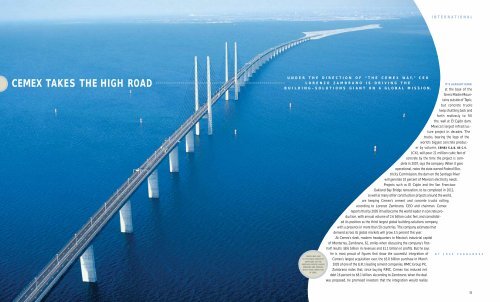CEMEX TAKES THE HIGH ROAD - tabpi
CEMEX TAKES THE HIGH ROAD - tabpi
CEMEX TAKES THE HIGH ROAD - tabpi
You also want an ePaper? Increase the reach of your titles
YUMPU automatically turns print PDFs into web optimized ePapers that Google loves.
INTERNATIONAL<br />
<strong>CEMEX</strong> <strong>TAKES</strong> <strong>THE</strong> <strong>HIGH</strong> <strong>ROAD</strong><br />
UNDER <strong>THE</strong> DIRECTION OF “<strong>THE</strong> <strong>CEMEX</strong> WAY,” CEO<br />
LORENZO ZAMBRANO IS DRIVING <strong>THE</strong><br />
IT’S ALREADY DARK<br />
BUILDING–SOLUTIONS GIANT ON A GLOBAL MISSION. at the base of the<br />
Sierra Madre Mountains<br />
outside of Tepic,<br />
but concrete trucks<br />
keep shuttling back and<br />
forth restlessly to fill<br />
the wall at El Cajón dam,<br />
Mexico’s largest infrastructure<br />
project in decades. The<br />
trucks, bearing the logo of the<br />
world’s biggest concrete producer<br />
by volume, <strong>CEMEX</strong> S.A.B. DE C.V.<br />
(CX), will pour 21 million cubic feet of<br />
concrete by the time the project is complete<br />
in 2007, says the company. When it goes<br />
operational, notes the state-owned Federal Electricity<br />
Commission, the dam on the Santiago River<br />
will generate 10 percent of Mexico’s electricity needs.<br />
Projects such as El Cajón and the San Francisco-<br />
Oakland Bay Bridge renovation, to be completed in 2012,<br />
as well as many other construction projects around the world,<br />
are keeping Cemex’s cement and concrete trucks rolling,<br />
according to Lorenzo Zambrano, CEO and chairman. Cemex<br />
reports that by 2005 it had become the world leader in concrete production,<br />
with annual volume of 2.6 billion cubic feet, and consolidated<br />
its position as the third largest global building-solutions company,<br />
with a presence in more than 50 countries. The company estimates that<br />
demand across its global markets will grow 3.5 percent this year.<br />
At Cemex’s sleek, modern headquarters in Mexico’s industrial capital<br />
of Monterrey, Zambrano, 62, smiles when discussing the company’s firsthalf<br />
results: $8.6 billion in revenues and $1.1 billion in profits. But he says<br />
he is most proud of figures that show the successful integration of<br />
<strong>CEMEX</strong> WAS ONE<br />
OF <strong>THE</strong> MAIN CONCRETE Cemex’s largest acquisition ever, the $5.8 billion purchase in March<br />
SUPPLIERS ON <strong>THE</strong><br />
ORESUND BRIDGE LINKING 2005 of one of the U.K.’s leading cement companies, RMC Group Plc.<br />
DENMARK AND SWEDEN,<br />
WHICH WAS COMPLETED Zambrano notes that, since buying RMC, Cemex has reduced net<br />
IN 1999.<br />
debt 16 percent to $8.1 billion. According to Zambrano, when the deal<br />
was proposed, he promised investors that the integration would realize<br />
B Y J O S É F E R N A N D E Z<br />
21
WHEN<br />
COMPLETED, <strong>THE</strong> EL<br />
CAJÓN DAM WILL<br />
CONTAIN MORE THAN<br />
21 MILLION CUBIC<br />
FEET OF CONCRETE.<br />
$200 million in annual synergies by the end of this year.<br />
Instead, Zambrano says, Cemex is set to achieve $360 million<br />
this year alone. What’s more, Cemex estimates it will<br />
have $2.5 billion in free cash flow by year-end 2006.<br />
That, says Zambrano, leaves the company in a strong<br />
position to continue the expansion juggernaut that<br />
he initiated in 1987, two years after becoming CEO.<br />
<strong>THE</strong> <strong>CEMEX</strong> WAY<br />
Since Zambrano took the top spot, Cemex has<br />
made more than a dozen acquisitions. The secret,<br />
says the CEO, is a management system known as<br />
“The Cemex Way,” which has been taught in<br />
business schools around the world, including<br />
Harvard University, Massachusetts Institute of<br />
Technology and Stanford University, Zambrano’s<br />
alma mater. “Essentially, it is internal benchmarking<br />
in MBA speak,” explains Zambrano, who is also<br />
chairman of the board of Instituto Tecnológico y de<br />
Estudios Superiores de Monterrey (ITESM), Mexico’s<br />
largest private university.<br />
According to Zambrano, by diligently amassing data,<br />
Cemex measures every step of production, sales and administration,<br />
including energy consumption, inventory and delivery. Once<br />
numbers flag rising costs, the company swings into action. For<br />
instance, energy costs, which typically represent about a third of the<br />
cost of cement production, rose 118 percent from 2001 through 2005,<br />
says Zambrano. Yet the the company says its energy cost per ton of concrete<br />
produced rose only 11 percent after its plants implemented fuel-injection<br />
systems and temperature-control mechanisms.<br />
SINCE ZAMBRANO BECAME CEO,<br />
<strong>CEMEX</strong> HAS MADE MORE T H A N<br />
A DOZEN ACQUISITIONS.<br />
Cemex also remains open to new approaches to business, says Zambrano. When making its<br />
first big international acquisitions in 1992 of Spanish companies La Valenciana and Sanson, he<br />
says, Cemex discovered the Spanish plants were unusually efficient thanks to their use of petroleum<br />
coke, a solid fuel that is a by-product of oil refining, as their main fuel source. The CEO<br />
explains that, as part of an eco-efficiency program begun in 1994, most of Cemex’s 66 cement<br />
plants, except those located in areas where other energy sources are cheaper, now employ petroleum<br />
coke. The program, which also uses improved mining techniques, recycles and taps alternative<br />
materials that come as waste from other industries, such as blast-furnace slag and fly ash.<br />
This program has saved Cemex $75 million in energy costs altogether, says Zambrano.<br />
ALL IMAGES COURTESY <strong>CEMEX</strong><br />
RMC’s integration also exemplifies The Cemex Way at work, the CEO<br />
says. Once the acquisition had been cleared, a post-merger integration team<br />
of 400 executives, armed with laptops and the company’s cost-cutting and<br />
benchmarking mentality, headed for a six-month<br />
inspection of RMC plants in 22 countries with<br />
marching orders to implement Cemex’s<br />
methods and operation manuals.<br />
“There were weekly reviews by team<br />
and function, and monthly reports<br />
to the CEO,” notes Juan Pablo San<br />
Agustin, senior vice president of<br />
corporate strategic planning,<br />
who headed the RMC postmerger<br />
integration team.<br />
As an example of cost savings,<br />
Zambrano points to an RMC plant<br />
in Rugby, England, which boosted<br />
production to an average 90 percent of<br />
capacity from 74 percent in three months,<br />
simply by fine-tuning the plant alarm’s sensitivity<br />
to reduce production halts. “They are heroes,”<br />
In 1983, when his boss rejected his proposal to buy a<br />
computer to better control operations, Zambrano<br />
recalls, he reached into his own pocket to buy a then<br />
state-of-the-art Wang PC. He and two colleagues<br />
gathered data by phoning the company’s plants,<br />
and keyed the numbers into the computer to track<br />
performance. This, says Zambrano, opened the<br />
low-tech, hard-hat industry to the informationtechnology<br />
era. “I saw that the only way to<br />
keep track of what was going on in each<br />
plant was to have an information system,”<br />
Zambrano remembers.<br />
When appointed CEO in 1985, Zambrano<br />
says, one of his first initiatives was to<br />
launch CemexNet, a satellite network that<br />
performs the same data collection tasks he did<br />
with that first computer. Now, he notes, most<br />
Cemex delivery trucks are equipped with computers<br />
that map delivery routes and times and are<br />
tracked by global-positioning satellite technology.<br />
Customers can order online or by phone directly to<br />
says Zambrano of the integration team. “They left their families<br />
behind to work long hours to make the operation a real success.”<br />
Teams in different countries competed to achieve the fastest<br />
and most efficient integration, he recalls, noting that better tracking<br />
LORENZO ZAMBRANO<br />
OPENED <strong>THE</strong><br />
LOW-TECH, HARD-HAT<br />
CEMENT INDUSTRY TO<br />
<strong>THE</strong> INFORMATION<br />
TECHNOLOGY ERA.<br />
a computerized dispatching system. The result,<br />
says Zambrano, is that clients get their concrete<br />
where and when they want it. (See “A Heavy<br />
Industry’s High-Tech Brain,” page 25.)<br />
of materials gained $100 million in savings, and personnel reduction<br />
cut $70 million from overhead. At the end of the process some members<br />
of the team moved to markets they had overseen to run operations,<br />
while others returned to their countries of origin.<br />
<strong>THE</strong> ACQUISITION MACHINE<br />
The early embrace of information technology gave Cemex tools to<br />
grow quickly, Zambrano explains, noting the company had only five<br />
cement plants and 6,500 employees when he took over, compared to 66<br />
<strong>THE</strong> ZAMBRANO WAY<br />
Although Cemex was founded by his grandfather in 1906<br />
and Zambrano says he knew by age 14 that he wanted to<br />
run the company, his succession was not a foregone conclusion.<br />
After getting a degree in mechanical engineering<br />
fully owned cement plants and 50,000 employees today. But key to Cemex’s<br />
success, say observers, is its rigorous approach to integrating acquisitions.<br />
In choosing targets, Cemex says, its most basic<br />
criterion is return on equity: Acquisitions must<br />
have the potential to guarantee a 10 percent<br />
and administration from ITESM, he left for the<br />
U.S. to broaden his background with a Stanford<br />
University MBA. After joining the company at an<br />
entry-level engineering position in 1968, Zambrano<br />
says he made his way up, with stints as<br />
return by full integration time, a two-year<br />
frame in RMC’s case. Beyond that, the<br />
company looks at such benefits as<br />
geographic market share. For example,<br />
Zambrano says, RMC had operations<br />
plant manager, division manager and head of<br />
operations before taking the top post in 1985.<br />
Ten years later he added the chairman title.<br />
Zambrano credits his U.S. stay with instilling<br />
in him the value of critical thinking, a skill<br />
that he would later apply to transform<br />
Cemex, then a modest regional operation. “I<br />
learned from the flower-power movement to<br />
question the establishment,” he says.<br />
in Britain and 20 other (mostly<br />
European) countries.<br />
Zambrano acknowledges, however,<br />
that not every acquisition has been a<br />
success. In May, Cemex sold its 24.9 percent<br />
stake in Indonesian cement maker<br />
PT Semen Gresik Tbk after Cemex says<br />
the government blocked its bid to take<br />
control of the company.<br />
TODAY, <strong>CEMEX</strong>’S<br />
LARGEST SALES<br />
BY VOLUME ARE IN<br />
<strong>THE</strong> U.S.<br />
.<br />
22<br />
NYSE MAGAZINE 23
EMPHASIS ON TALENT<br />
Even more than information technol-<br />
work together on computer-science research projects to foster<br />
<strong>THE</strong> TEPEACA<br />
CEMENT PLANT<br />
the company’s performance. ITESM has similar programs<br />
IN PUEBLA,<br />
MEXICO IS ONE<br />
ogy, Cemex’s real key to success lies in with other multinational companies.<br />
candidates. “Human resources doesn’t<br />
particularly like it, but I want to make sure<br />
we get people with potential,” he says.<br />
Managing 50,000 employees from a variety<br />
of cultures and who speak many languages<br />
requires standardization, he acknowledges.<br />
He says Cemex aims for college graduates in<br />
the top 15 percent of their class who are fluent<br />
in English, noting that English is Cemex’s<br />
official language. The company has installed a<br />
clear career path to ensure the best of the new<br />
hires move up in the company. To make certain<br />
they understand Cemex’s goals, everyone, including<br />
consultants, attends an induction course. Tailored to<br />
each employee’s level, the presentation is constantly<br />
OF <strong>CEMEX</strong>’S<br />
66 FULLY OWNED<br />
its people, Zambrano insists. He says he<br />
PLANTS.<br />
likes to personally interview management GLOBAL REACH<br />
Although Cemex indicates it has a presence in 50<br />
countries, North America accounts for 48 percent<br />
of the company’s reported sales. With the RMC<br />
acquisition, Europe accounts for 38 percent; the<br />
remaining 14 percent is distributed among<br />
South America, Africa/Middle East and Asia.<br />
Zambrano sees opportunity even in Cemex’s<br />
primary markets. A 2004 Brookings Institution<br />
report estimates that half of all buildings in<br />
which U.S. citizens will live, shop and work by<br />
2030 haven’t been built yet. That’s good news for<br />
Cemex, which calls the U.S. its largest market by<br />
volume sales and second in revenues, after Mexico.<br />
The greatest U.S. expansion will occur in the South<br />
and West, reports Brookings, markets where Cemex<br />
revised but includes the basics of The Cemex Way as well as a<br />
tutorial on the technical and market aspects of the business, explains<br />
Zambrano. Beyond that, new employees are expected to attend several programs<br />
designed to maintain a spirit of professional growth and competition.<br />
Young managers are encouraged to take international positions to<br />
indicates it already dominates. Meanwhile, construction<br />
demand in Mexico is expected to parallel the country’s<br />
economic growth rate, estimated at 4 percent in 2006.<br />
The RMC deal put Cemex in a good position to take<br />
advantage of European construction opportunities, says the<br />
help implement a single business model globally.<br />
And the learning process continues beyond a new hire’s early days.<br />
About 7,000 employees have access to 261 e-learning courses on such<br />
topics as business fundamentals and management skills, which<br />
cover both Cemex operations and general business and manage-<br />
CEO. Cemex’s next logical move is to target rapidly<br />
growing markets, says Francisco Chavez*, senior<br />
analyst with BBVA Bancomer S.A., a<br />
division of BANCO BILBAO VIZCAYA ARGEN-<br />
TARIA S.A. (BBV). “Definitely, expansion<br />
YOUNG MANAGERS ARE ENCOURAGED TO TAKE<br />
INTERNATIONAL POSITIONS TO HELP<br />
IMPLEMENT <strong>CEMEX</strong>’S BUSINESS MODEL GLOBALLY.<br />
rial skills. Zambrano says it is not a coincidence<br />
that he chairs the board at his undergraduate<br />
school. ITESM is not only Mexico’s largest private<br />
university, but it is also a natural source<br />
of IT talent for Cemex and increasingly for<br />
other multinationals, the CEO explains. He<br />
points to a joint program between the company<br />
and ITESM: In the $300,000 innovationcell<br />
program, half funded by Cemex, students<br />
plans are back on the table now that leverage indicators have<br />
decreased to comfortable levels,” he says. Noting that any area could<br />
be a target since the Cemex formula is a proven one, Chavez nevertheless<br />
singles out China as an especially attractive market. China, the world’s<br />
biggest cement consumer for the past 10 years, is expected to continue its<br />
demand for decades to come, reports the U.S. Geological Survey.<br />
For his part, Zambrano has expressed interest in the BRIC nations<br />
(Brazil, Russia, India and China), citing rapid growth projections<br />
that will pump up demand for cement as they build infrastructure<br />
<strong>CEMEX</strong>’S<br />
STATE-OF-<strong>THE</strong>-ART<br />
INFORMATION-<br />
TECHNOLOGY CENTER<br />
IN MONTERREY.<br />
projects. Although concerns with those markets have prevented<br />
Cemex from entering them so far, Zambrano says, he keeps an eye on<br />
them, with “terabytes” of information on China and a full-time analyst<br />
checking for opportunities there. Other targets are companies where<br />
Cemex’s integration know-how would increase market value, Zambrano says.<br />
If the right opportunities don’t surface immediately, though, Zambrano suggests<br />
the company’s estimated $2.5 billion free cash flow would go to reducing debt at the end<br />
of 2006. As the company celebrates its 100th anniversary, Zambrano makes clear that<br />
“RMC is not Cemex’s last acquisition. The best,” he insists, “is yet to come.”<br />
A HEAVY INDUSTRY’S<br />
<strong>HIGH</strong>-TECH BRAIN<br />
<strong>CEMEX</strong>’S TECHNOLOGY CENTER, located in Monterrey, Mexico, but housed in a<br />
location separate from headquarters, looks like a science-fiction film set. According to the<br />
company, access is restricted to a handful of employees who enter through high-security,<br />
double sliding doors. Inside, a transparent floor lets technicians see cables underneath<br />
while blue light glows with a spaceshiplike effect. This is home to the computer servers<br />
that back up company information collected daily, going back to 1987: millions of<br />
incoming e-mails and internal messages between employees in 50 nations and<br />
phone lines connected by voice over Internet protocol. All billing processes,<br />
which include thousands of operations a day, come to this windowless facility.<br />
“Operations here are critical to the company,” says Fulgencio Garza, the<br />
global IT-services operations manager. “We are on call 24 hours a day.” The<br />
IT team’s mission, he explains, is to continually improve global integration.<br />
Computer templates for many office tasks, for instance, are the<br />
same for every Cemex office in the world. “That makes all executives<br />
more productive when they travel around the world,”<br />
says Romeo Siquijor, IT operations data center manager.<br />
Apart from the company’s operations, Cemex<br />
reports, the network deployment is used for<br />
videoconferencing, e-learning applications<br />
and other productivity-boosting activities.<br />
Cemex indicates that its use of information<br />
technology has been such a success that<br />
a decade ago it decided to spin off a part of<br />
the department into a subsidiary. From that<br />
was born Neoris, which the research firm IDC<br />
now ranks as Mexico’s largest IT consultant by<br />
revenues. At first Neoris depended solely on its<br />
parent, according to Cemex, but around half of<br />
its 2005 sales came from outside customers.<br />
* Francisco Chavez, an analyst with BBVA Bancomer S.A., is<br />
not an officer, director or member of an advisory board at<br />
Cemex. Neither he nor his firm owns positions in Cemex.<br />
<strong>CEMEX</strong> EXPECTS<br />
THAT MOST OF ITS U.S.<br />
EXPANSION WILL<br />
OCCUR IN <strong>THE</strong> SOUTH<br />
AND WEST; THIS<br />
POOL IS IN PHOENIX.<br />
24<br />
NYSE MAGAZINE













